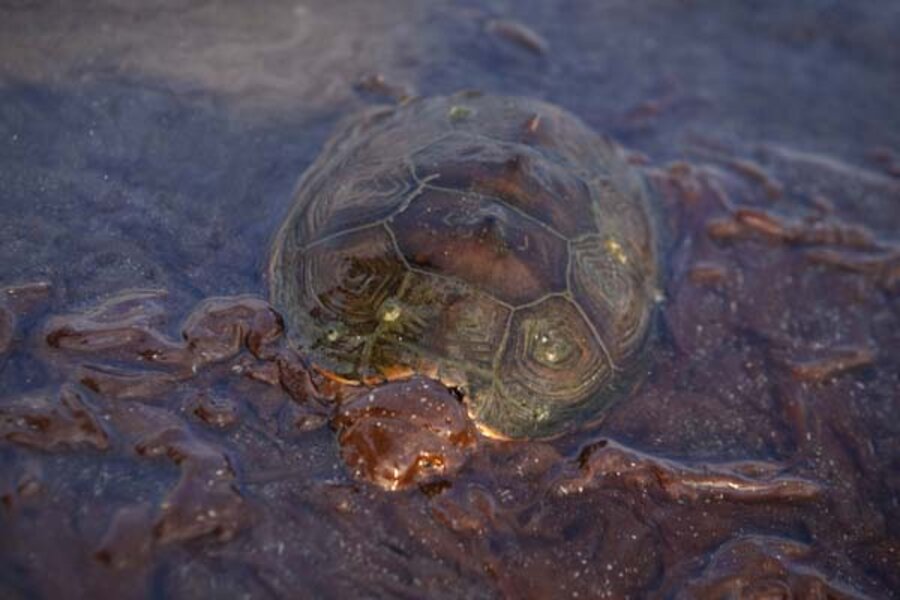Sea turtles: wildlife experts set to collect and move eggs away from Gulf oil spill
Loading...
| Los Angeles
U.S. wildlife experts are preparing to collect tens of thousands of endangered sea turtle eggs and move them hundreds of miles away in an unprecedented bid to protect them from the BP Plc (BP.N) (BP.L) oil spill in the Gulf of Mexico.
Plans call for relocating 700 to 800 clutches of eggs left newly buried on the sandy beaches of Alabama and northwestern Florida -- accounting for the bulk of turtle nests in the northern Gulf, U.S. Fish and Wildlife Service spokesman Charles Underwood said on Monday.
"Relocating sea turtle nests on occasion, nest by nest, in very small numbers, has been done before (but) nothing has even been considered at this massive scale," Underwood told Reuters. "It's never been attempted anywhere in the world."
IN PICTURES: Gulf oil spill's impact on nature
Most of the nests designated for removal are those of the loggerhead turtle, the world's largest hard-shelled turtle, growing to an average adult weight of 250 pounds (113 kg). The loggerhead is the most prevalent of five species of threatened or endangered sea turtles that inhabit the U.S. Gulf Coast.
The project also will include a handful of nests from other species -- Kemp's ridley, leatherback and green turtles.
Concerns about the well-being of turtles have run especially high since the spill began because it coincided with the reptiles' breeding season.
While the strategy is largely untested, the grave consequences of leaving the nests undisturbed are certain.
If allowed to hatch on their own without being moved, the baby turtles emerging from those nests would likely swim directly into the mass of crude oil spewing into the Gulf since late April from a ruptured BP well and now encroaching on Alabama and the Florida panhandle.
'DEATH SENTENCE'
"It's almost certainly a death sentence," Underwood said. "We'd expect to lose most, if not all of them" -- representing virtually all of the 2010 U.S. Gulf Coast sea turtle hatchlings.
Later this month, wildlife teams will begin the painstaking process of digging up eggs from the nests, placing them in special containers covered with sand and shipping them by truck to the Atlantic coast of central Florida.
There the eggs will be kept in temperature-controlled holding facilities until their incubation is complete and they begin to hatch. The hatchlings will then be carried by hand to the beach and released near the water's edge, Underwood said.
At least 50,000 baby turtles are expected to emerge, assuming roughly 70 eggs from each of 700 nests survive the transfer and incubation period. The clutch size, or number of eggs per nest, generally vary from 100 to 126 eggs, each laid by a single female turtle who may come ashore to nest as many as four times during the spring.
Some 4,000-plus turtle nesting sites along the beaches of southwestern Florida and the Florida Keys are being left undisturbed because the spill poses a far smaller threat to them, Underwood said.
The success of the relocation remains to be seen, but biologists are taking care to improve the turtles' odds such as placing the eggs in storage as closely as possible to their exact orientation in the nests, Underwood said.
According to the Fish and Wildlife Service, more than 550 sea turtles have been found dead and debilitated along the U.S. Gulf Coast to date, about double the number reported a month ago when the agency first began posting daily tallies.
Many were found without visible signs of oil exposure, and further tests are necessary to determine if oil was a culprit, said Dr. Robert Ziccardi, a professor at the University of California at Davis who heads the Oiled Wildlife Care Network.
He has overseen rescue efforts for sea turtles and marine mammals throughout the Gulf since the spill.
One potential spill-related cause of turtle mortality that has raised alarms but remains unconfirmed is the controlled burning of patches of oil slick at the Gulf surface. Ziccardi said some turtles had "likely" perished in the process but "we don't have any evidence to prove it one way or the other."
As a precaution, wildlife observers are being assigned to work with the controlled-burn teams to look for and collect turtles around parts of the slick before they are set ablaze, he said. And no burning is allowed in areas where turtles and other wildlife have been spotted.
The controlled burns are still widely regarded as preferable to letting the slick wash into sensitive coastal areas where they do greater environmental harm, he said.
"There are trade-offs," he said. "The Coast Guard has been extremely cooperative on the things we're attempting to do to get turtles out of harms' way, if possible."
Related:
- Gulf oil spill's wildlife toll: sharks near shore, turtles incinerated
- Gulf oil spill: What's the impact on national parks?
- Oil spill: What is the threat to Gulf of Mexico seafood?
IN PICTURES: Gulf oil spill's impact on nature





